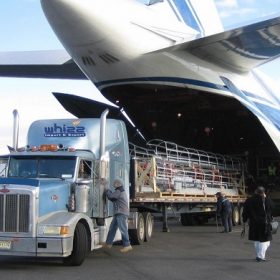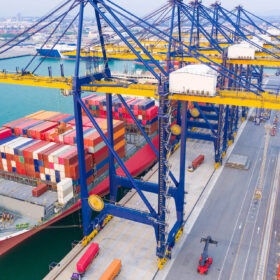Semanas atrás tuvo lugar la inauguración de la ampliación del Canal de Panamá, esa impresionante obra de la ingeniería humana que supuso un avance para el comercio internacional. Ahora, la comunicación entre los dos oceános pasará a ser más fluida, hecho que tal vez ayude al puerto de Colón a liderar el próximo año el ranking de movimiento de contenedores en los puertos de Latinoamérica que cada año realiza la Comisión Económica para América Latina y el Caribe (CEPAL). O incluso a evitar el sorpasso del puerto colombiano de Cartagena a Balboa, que de mantenerse las tendencias, podría producirse en un par de años.
La tabla la lidera el puerto brasileño de Santos, con 3.569.870 de TEU’s durante 2015, un incremento del 2,1% con respecto al año anterior. El segundo y tercer puesto lo ocupan los puertos panameños anteriormente citados, y cierran el top 5 Cartagena, con el mayor incremento del ranking (16,6%) y Manzanillo, en México.
TEU es el acrónimo del término inglés Twenty-foot Equivalent Unit, y representa la medición estándar equivalente a un contenedor de 20 pies, es decir, la caja metálica de tamaño estandarizado que puede ser transferida fácilmente entre diferentes formas de transporte como buques, trenes y camiones.
Los datos confirman las dos tendencias observadas los últimos años, esto es, la desaceleración del comercio exterior en los terminales de contenedores y una alta heterogeneidad de las tasas de crecimiento dentro de la región. El movimiento de carga contenerizada crece un 1,7%, aunque debido a la caída en la dinámica comercial de países como Brasil, Perú, Puerto Rico, Trinidad y Tobago o Venezuela, se ha generado un impacto negativo en el crecimiento del volumen de carga, que no alcanza el 2% desde 2012.
En cualquier caso, el reporte destaca el crecimiento de Ecuador (6,3%) y el del puerto de Buenaventura en Colombia (6,6%), que está llamado a ser el próximo puerto en crecer exponencialmente tras la instalación de cuatro pórticos más para contenedores para un total de 16 grúas.
Precisamente Colombia (13,1%), junto a Nicaragua (24,4%), Barbados (10,3%), San Vicente y Las Granadinas (11,3%), Monserrat (11,7%) y Anguila (27,7%), forma parte de los 6 países que registran un alza general de dos dígitos.
También están entre los 10 primeros, el puerto de Callao en Perú, el de Buenos Aires y los de Kingston (Jamaica) y Freeport (Bahamas) en el Caribe.
Con estos datos, las máximas autoridades portuarias discutirán el futuro de los puertos de América Latina en el próximo Congreso Latinoamericano de Puertos organizado por la AAPA que tendrá lugar en México entre el 29 de noviembre y el 2 de diciembre.
 [:en]Few weeks ago, the Panama Canal Expansion inaugural ceremony took place. An impressive engineering work which brought a progress for the international commerce. Now, communication between the two oceans will be fluent, fact that, presumably, will help port of Colon to lead the container throughput in Latin America ranking which is done by the Economical Commission for Latin America and Caribbean (CEPAL). Or maybe, it will help port of Colon to avoid the overcoming of the Colombian port to Balboa, which in case it remains steady, it could be produced in two years.
[:en]Few weeks ago, the Panama Canal Expansion inaugural ceremony took place. An impressive engineering work which brought a progress for the international commerce. Now, communication between the two oceans will be fluent, fact that, presumably, will help port of Colon to lead the container throughput in Latin America ranking which is done by the Economical Commission for Latin America and Caribbean (CEPAL). Or maybe, it will help port of Colon to avoid the overcoming of the Colombian port to Balboa, which in case it remains steady, it could be produced in two years.
The Brazilian port of Santos leads the board, with 3.569.870 of TEU’s during 2015, an increase of 21% compared with previous year. Second and third position are for the previously said Panamanian ports. And Cartagena, with the biggest ranking increase (16.6%) and Manzanillo, in Mexico, close the top five.
TEU is the acronym for Twenty-foot Equivalent Unit, and it represents the standard equivalent measure of a 20-foot container, in other words, the metallic standardized size box which can be transferred easily in many different transport ways, like ships, trains or trucks.
The figures confirm the two main trends observed last years, which are foreign trade’s slowdown at container terminals and growth rates’ high heterogeneity within the region. Containerized cargo’s movement increases by 1.7%, although due to the trade dynamic’s decline in countries like Brazil, Peru, Puerto Rico, Trinidad and Tobago or Venezuela, a negative impact has been done in load volume growth, without reaching 2% since 2012.
Anyway, the report notes the Equator’s growth (6.3%) and the one of the port of Buenaventura in Colombia (6.6%), which is called to be the next port in having and exponential development after the installation of four more gantries for containers, a total of 16 cranes.
Precisely Colombia, (13.1%), together with Nicaragua (24.4%), Barbados (10.3%), Saint Vincent and the Grenadines (11.3%), Monserrat (11.7%) and Anguilla (27.7%) is one of the six countries having an overall increase of two digits.
There are also among the first 10, the port of Callao in Peru, the Buenos Aires’ port and the Kingston’s (Jamaica) and Freeport’s (Bahamas) in the Caribbean.
With these figures, highest port authorities will discuss about the future of Latin America’s ports in the next Latin America’s Port Congress organized by AAPA and taking place in Mexico between November 29th and December 2nd.[:]
 Español
Español



